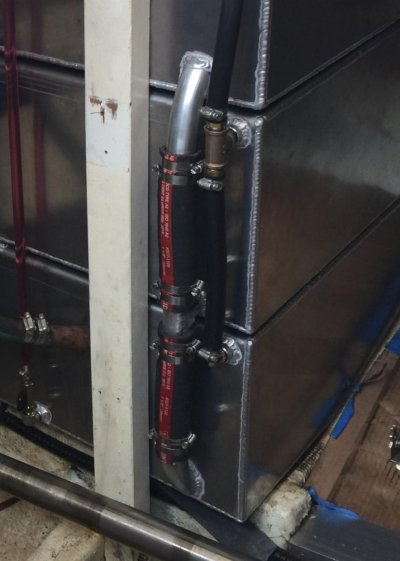Giggitoni
Guru
- Joined
- Jun 21, 2008
- Messages
- 2,097
- Location
- United States
- Vessel Name
- Mahalo Moi
- Vessel Make
- 1986 Grand Banks 42 Classic
The topic of fuel tank replacement comes up on the forum from time to time. Now it's my turn.
Last October, I detected a small amount of fuel in the bilge of my GB42. I use red-dyed diesel so it's easy to see! I looked at every possible angle, nook and cranny where the fuel might be leaking. I tried to talk myself into the notion that it could be a bad fitting, leaking sight tube, leaking fuel filter, fuel pump, etc. I tried to ignore the fact the tanks were 29 year old black iron! The journey took my troubleshooting full circle. It had to be the port fuel tank.
My GB was built with two 300-gallon fuel tanks; one port and one starboard. It was time for the tanks to be replaced.
I'm the fifth owner of this boat. The previous four owners escaped the inevitable! I was the one holding the bag. I was the one left standing when all the others were sitting!
I called a local company in the San Francisco Bay Area to meet me at the boat and give me a cost estimate. Long story short, that company was reluctant to do the work for the price that a company in La Mesa, California was quoting. So I called "Vince" at American Tanks in La Mesa, Califonia for advice.
I've read about the reputation of American Tanks through the years on the GB Owners Forum (Grand Banks Owner's Resources). I had no idea that he would be willing to come to Vallejo (about 425 miles from my boat) to replace my tanks. In fact, he said that he would reduce the price by $2,000 if I would bring the boat to him! Side note: It would cost me at least that much in fuel to get the boat down there and back. Besides, the Coast Guard could easily find me with the diesel slick I'd be pumping out in the Pacific Ocean all the way the California coast.
Vince drove up to Vallejo and pumped the fuel from the leaking tank into 55-gallon drums placed on my cockpit. This was a big relief to me because I wouldn't have to visit the boat every two to three days to change the absorbent pads in the bilge (the last thing I needed was to pump fuel into the marina with the bilge pump). He also took copious measurements of the tanks, opening through my sole to the engine room, width of the saloon doors, etc.
He returned recently with six aluminum tanks; three on each side. I lost about 50 gallons of fuel capacity total (25 gallons on each side). So now I have about 275 gallons on each side for a total fuel volume of about 550 gallons. Fine with me. And since the fuel tanks are placed about midships, I don't have a forward-to-aft trim problem.
The old tanks were cut out quickly by a 22-year-old dude with a reciprocating saw and a bunch of blades! Join me when I sing the praises of the younger generation that's willing to put in an honest day's work! It's no problem cutting out old diesel tanks with an electric saw. No fires or explosions! No need to fill with inert gas, etc. Gasoline tanks would be a different story!
The new tanks were installed and joined together with connections which make them work as "one tank" on each side. Sight tubes, cross over line, fuel intake and return lines, and generator lines were installed. I also had American Tanks install a separate valve and connection for my diesel heater.
The install went well. I know you're wondering....how much? The total bill was just shy of $19,000. But worth every penny!
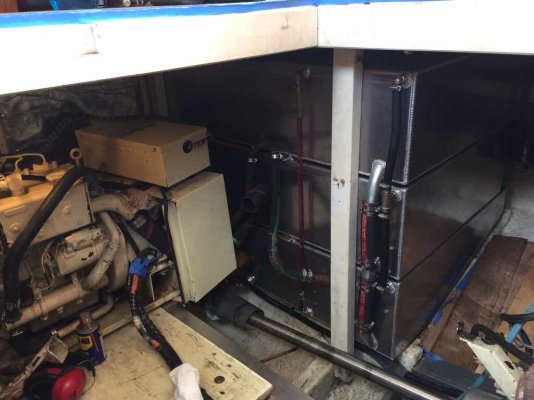
Port side tanks installed
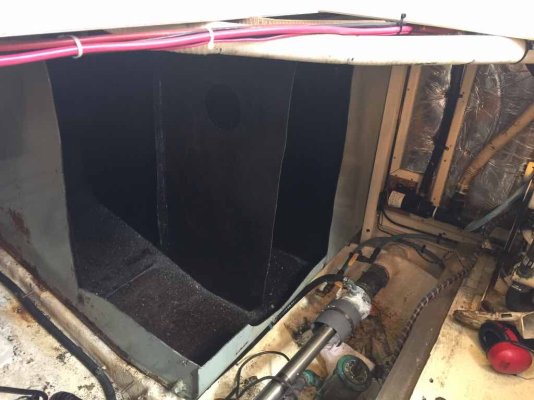
Cutting out starboard tank
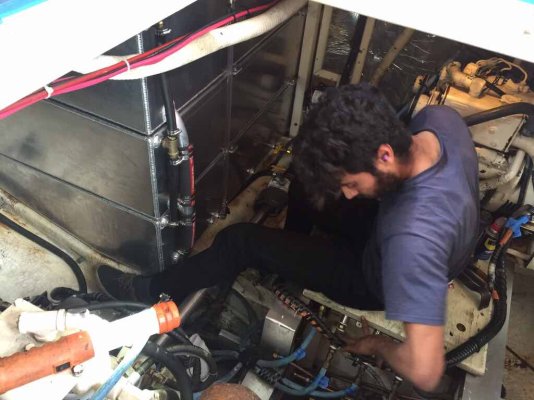
Connecting starboard tank lines
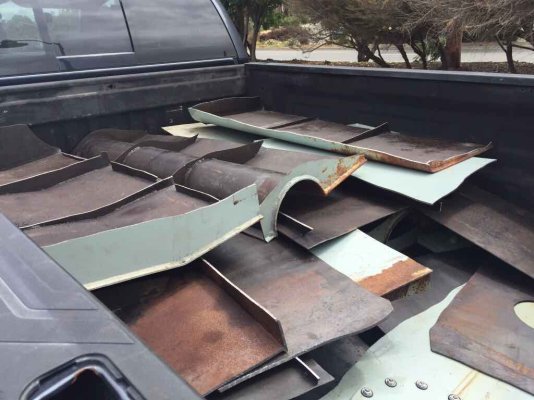
Removed tank pieces in back of pickup truck
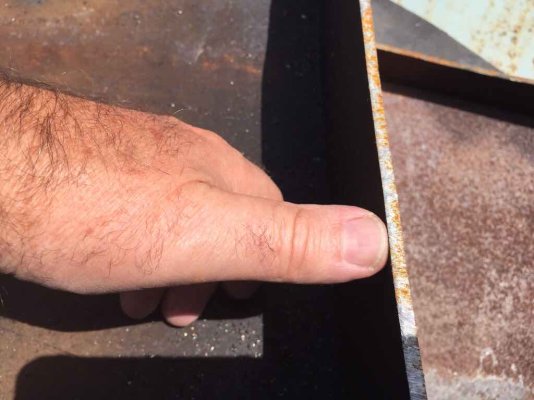
Thickness of original tanks

Bottom section of port tank that was leaking. The rectangular rust shape is a result of water being trapped under a neoprene pad under that corner of the tank. Notice the three holes (about 1-1.5mm in diameter). I poked those holes through the rust with my truck ignition key! The steel was "paper" thin. I'm fortunate that the slow leak didn't let go all at once!
Last October, I detected a small amount of fuel in the bilge of my GB42. I use red-dyed diesel so it's easy to see! I looked at every possible angle, nook and cranny where the fuel might be leaking. I tried to talk myself into the notion that it could be a bad fitting, leaking sight tube, leaking fuel filter, fuel pump, etc. I tried to ignore the fact the tanks were 29 year old black iron! The journey took my troubleshooting full circle. It had to be the port fuel tank.
My GB was built with two 300-gallon fuel tanks; one port and one starboard. It was time for the tanks to be replaced.
I'm the fifth owner of this boat. The previous four owners escaped the inevitable! I was the one holding the bag. I was the one left standing when all the others were sitting!
I called a local company in the San Francisco Bay Area to meet me at the boat and give me a cost estimate. Long story short, that company was reluctant to do the work for the price that a company in La Mesa, California was quoting. So I called "Vince" at American Tanks in La Mesa, Califonia for advice.
I've read about the reputation of American Tanks through the years on the GB Owners Forum (Grand Banks Owner's Resources). I had no idea that he would be willing to come to Vallejo (about 425 miles from my boat) to replace my tanks. In fact, he said that he would reduce the price by $2,000 if I would bring the boat to him! Side note: It would cost me at least that much in fuel to get the boat down there and back. Besides, the Coast Guard could easily find me with the diesel slick I'd be pumping out in the Pacific Ocean all the way the California coast.
Vince drove up to Vallejo and pumped the fuel from the leaking tank into 55-gallon drums placed on my cockpit. This was a big relief to me because I wouldn't have to visit the boat every two to three days to change the absorbent pads in the bilge (the last thing I needed was to pump fuel into the marina with the bilge pump). He also took copious measurements of the tanks, opening through my sole to the engine room, width of the saloon doors, etc.
He returned recently with six aluminum tanks; three on each side. I lost about 50 gallons of fuel capacity total (25 gallons on each side). So now I have about 275 gallons on each side for a total fuel volume of about 550 gallons. Fine with me. And since the fuel tanks are placed about midships, I don't have a forward-to-aft trim problem.
The old tanks were cut out quickly by a 22-year-old dude with a reciprocating saw and a bunch of blades! Join me when I sing the praises of the younger generation that's willing to put in an honest day's work! It's no problem cutting out old diesel tanks with an electric saw. No fires or explosions! No need to fill with inert gas, etc. Gasoline tanks would be a different story!
The new tanks were installed and joined together with connections which make them work as "one tank" on each side. Sight tubes, cross over line, fuel intake and return lines, and generator lines were installed. I also had American Tanks install a separate valve and connection for my diesel heater.
The install went well. I know you're wondering....how much? The total bill was just shy of $19,000. But worth every penny!

Port side tanks installed

Cutting out starboard tank

Connecting starboard tank lines

Removed tank pieces in back of pickup truck

Thickness of original tanks

Bottom section of port tank that was leaking. The rectangular rust shape is a result of water being trapped under a neoprene pad under that corner of the tank. Notice the three holes (about 1-1.5mm in diameter). I poked those holes through the rust with my truck ignition key! The steel was "paper" thin. I'm fortunate that the slow leak didn't let go all at once!
Last edited:



